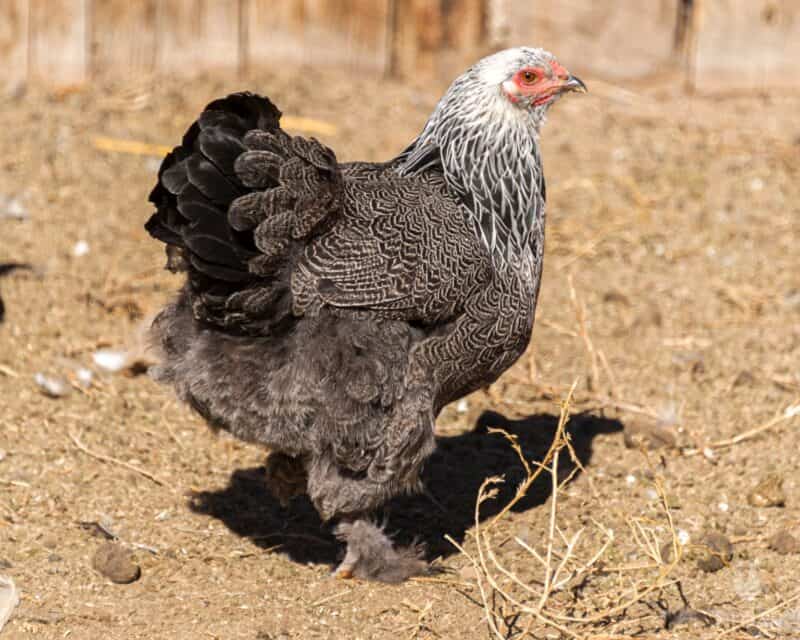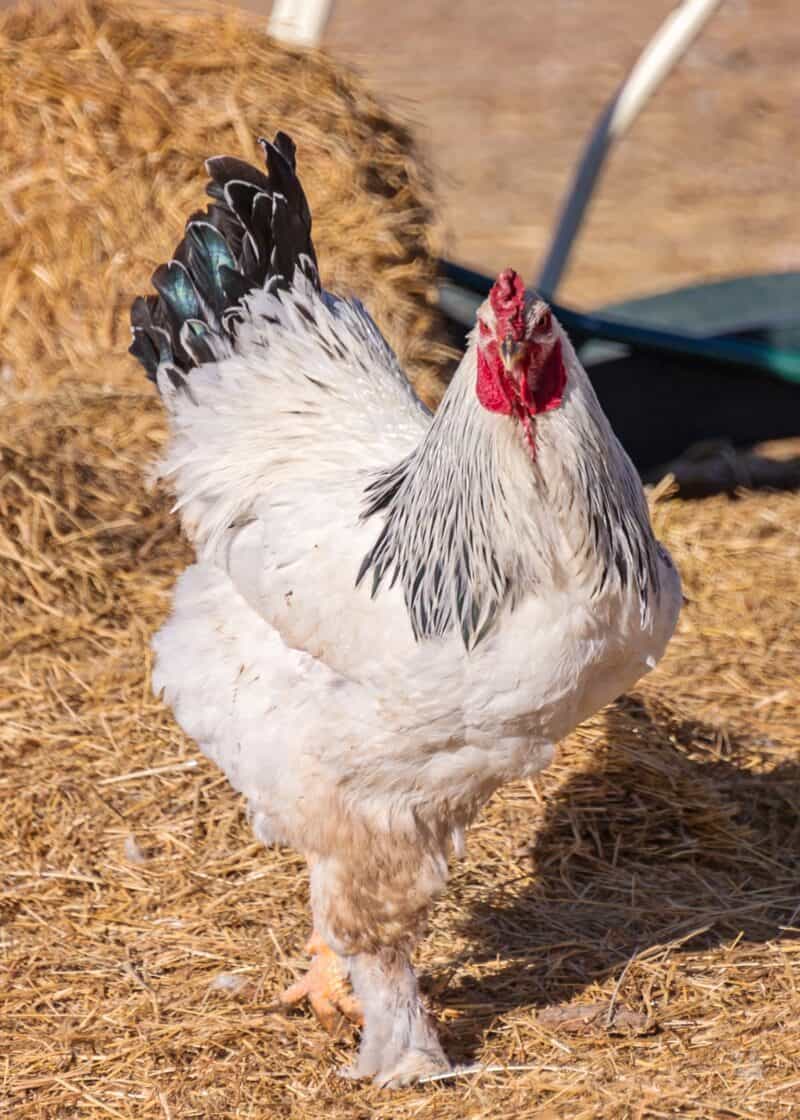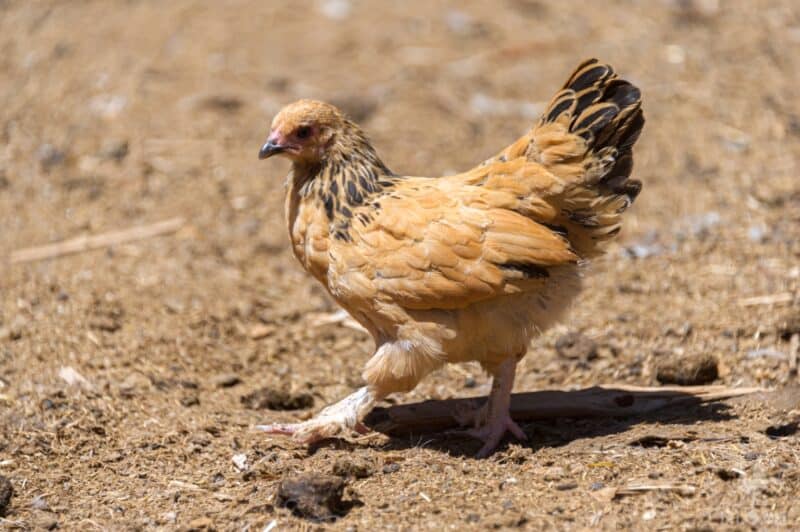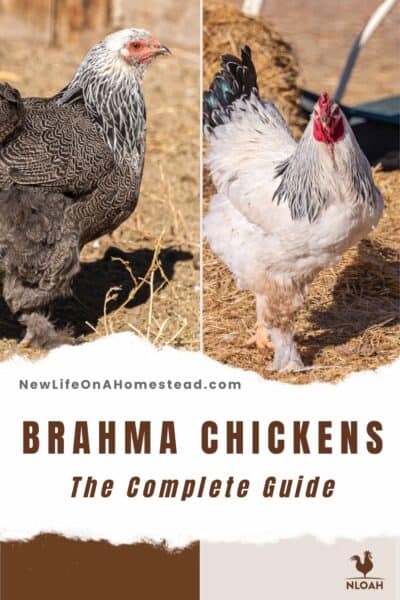Whether you’re getting started with chickens for the first time or just looking to expand your flock with some new additions, picking the right breed is crucially important.

Understanding the capabilities, health, temperament, and other essential characteristics of a breed will go a long way toward making your time with them happy and productive.
To help you find the perfect first bird or just the next ideal addition to your flock, I’m bringing you a breed guide for the Brahma, a beefy, all-American original that is friendly, easy to handle, and a fine choice for meat and eggs.
Ready to learn everything there is to know about them? Then let’s get going.
What are Brahmas?
The Brahma is an extra-large dual-use American chicken breed renowned for its docility and friendly temperament, surprising output of large brown eggs, and large yield of meat.
They are a particularly good chicken to raise as roasters, and despite their large size, are a great choice for beginners and veteran chicken keepers alike.
History of the Breed
If you were even passingly familiar with the word, you might think that Brahma implies an Indian or other Asian heritage, but in this case, you’d be only partially correct. As mentioned above, the Brahma is an American original, bred from various imported Asian chickens that first arrived on U.S. shores from China.
Fortunately, the genesis of this massive breed is lost to time, and we don’t know what specific chickens or lineages were used to produce them, but there is no question that the Brahma has existed more or less exactly as it has since the mid-18th century.
Brahmas are obviously huge birds, and they are in fact the second biggest US chicken breed, right behind the Jersey Giant which has only just edged it out in recent decades. Immense size meant that the Brahma was incredibly important commercially, and it was the breed that was used for meat production around the country for many years.
But despite this hulking physique, Brahmas also proved to be surprisingly good layers, giving them added commercial appeal, and also lending them to smaller operations that needed a true dual-purpose chicken.
Although they’ve long since been eclipsed in terms of output and efficiency by other breeds, a Brahma’s highly productive characteristics, gentle temperament, and novel size make them the darlings of homesteaders and backyard keepers to this day.
Be careful, though, because these birds are so big everything else in their lives must be bigger to accommodate them!
What’s the Breed Standard for Brahmas?
The American Poultry Association, or APA, breed standard for the Brahma specifies it as Asiatic with a heavy, thick body, with a V-shaped profile when viewed from the side.
These birds are tall, standing around two and a half feet. Roosters should be at least 10 pounds, hens a little lighter at no less than 8 pounds.
The APA also specifies a pea comb and hooded or “beetle” brow, where the forehead slightly covers the eyes. The beak is conical, short, and stout, with plentiful and tight plumage over top and thick underdown.
The legs have heavy, thick scaling and are covered in shaggy feathers all the way down to the feet.
Typical Size and Weight of Brahmas
Brahmas are big, chunky chickens as mentioned. Very big! Roosters commonly weigh around 12 pounds or a little bit more, and hens are routinely a substantial 10 pounds or even a smidge heavier.
Note that the APA standards allow roosters and hens that are slightly lighter than this average, though.
These are some hefty cluckers! But as big as they are, they used to be a whole lot bigger back in the 19th century, growing beyond 15 pounds if you can believe it! The modern Jersey Giant doesn’t even get that big sometimes…
What Colors of Plumage Do Brahma Chickens Come In?
The APA-accepted colors, as mentioned, are buff, light, and dark, but other standard colors recognized around the world and still available in the United States include blue, black, crele, barred, and partridge.
Combined with that thick, luxurious feathering, boots, and impressive stature, all plumage colors really do look impressive on these magnificent birds…
What Are Brahmas Good For?
Brahmas are a dual-purpose breed, meaning they are dependable producers of both meat and eggs.
Brahma carcass yields are substantial, and whole birds make a wonderful roaster for a holiday meal or other special occasion, or if you just have a large family or lots of guests coming over!
And, as surprising as it might seem, Brahmas are pretty prolific layers for such large birds, with healthy hens cranking out about 150 very large brown eggs yearly.
They also make popular pets thanks to their gentleness, agreeableness, and ease of handling. They really are gentle giants!
Temperament
As mentioned, Brahmas aren’t prone to using their great size and strength out of order. Fights among their own kind are rare, and even when roosters square off to establish dominance, such fights rarely go on a long time or result in true injury.
If you raise them right, Brahmas will be downright friendly, and though the temptation to pick up and cuddle such a stout bird is definitely there, I advise against it because dropping them can cause injury.
In mixed flocks, Brahmas can generally take care of themselves and aren’t aggressive, but every now and then they will put their size to use in order to move themselves higher up on the pecking order. This means you do need to keep an eye on them if you have any known aggressive birds or ones that are sheepishly incapable of holding their ground.
All in all, they are a joy to keep and very easy to handle…

Rooster Aggression
Among most other domestic breeds, Brahmas rate pretty low on the rooster aggression scale, though you should never turn your back on one of these big boys if you aren’t very familiar and comfortable with them.
They tend to be more standoffish and aloof than aggressive, there’s no telling what they’ll do when they are ready to mate or feeling territorial: trust me, you do not want to get flogged or spurred by a Brahma!
That said, they have a reputation for being very agreeable with people as long as they are raised from chicks and given plenty of socialization and other interaction.
Noisiness
Brahmas are considered below average when it comes to noisiness. These birds have a general demeanor that can be considered reserved, even polite.
Roosters do crow, of course, but they aren’t as loud or as piercing as their size would suggest, and they do not crow relentlessly as a rule unless something is really wrong.
Hens, likewise, might cluck and chatter among themselves, and are known to coo softly and contentedly when happy, but they aren’t particularly noisy.
Are Brahma Chickens Good Layers?
Brahma hens are fairly good layers, though considered below average compared to most domestic breeds, at around 150 eggs a year. They’re also known to lay straight through the winter, which is great if you want to keep the eggs coming all year long.
However, among other large breeds, they are considered quite prolific, as they lay very large eggs! This is something to keep in mind because a Brahma egg is worth about one and a half smaller chicken eggs.
A couple of Brahma hens can easily keep your family and your neighbors rolling in eggs with no problems, although they aren’t going to break any records and aren’t productive enough for most commercial ventures these days…
When Do Brahmas Start Laying?
One of the major disadvantages of Brahmas is that they grow slowly compared to other breeds, and hens only reach sexual maturity and begin laying at around 7 months of age at the earliest.
Every once in a blue moon, you might see one of these big girls mature slightly earlier, but this is unlikely.
What Color Eggs Do Brahmas Lay?
Brahmas lay brown eggs.
Broodiness
Another great thing about Brahmas: they aren’t very broody! That’s a good thing because hens are not good sitters. They’re just too big, heavy, bulky, and clumsy compared to other birds and they have a tendency to damage their own eggs. Sad, but true.
Nonetheless, this is just more incentive for you to stay on top of egg collection so they don’t get crushed in case mom gets the wrong idea.
Combined with their usual tendency to lay straight through the wintertime, you shouldn’t have any difficulty getting maximum productivity from your Brahma hens.
How Long Do Brahma Chickens Usually Live?
Brahmas have an average lifespan for a chicken, or slightly below average, living around 5 to 8 years. Individual chickens that live any longer than that will be rare.
What Do Brahma Chickens Eat?
Brahmas eat all of the same things that other chickens eat, they just eat a whole lot more of it!
Brahmas need a nutritionally well-rounded and fortified chicken feed as the mainstay item of their diet, and along with this a good selection of various supplemental whole foods and other natural items that would be a part of their wild diet. Bugs, meat, fruit, veggies, grains, and more are all okay.
However, anything that you want a Brahma to eat you need to be prepared to give it to them yourself. Brahmas aren’t immobile, far from it, but they aren’t great hunters and foragers.
They tend to only find and eat the choicest and most obvious bits of food in their environment, and they won’t enthusiastically chase after bugs and smaller creatures like game breeds will, or the adventurous and energetic Faverolles, for instance
But you don’t have to worry about this as long as you prepare a good mixed menu for your Brahmas.

Any Special Health Concerns These Birds Need to Worry About?
Yes. Brahmas are remarkably healthy in many ways and notably tend not to suffer from too many genetic defects or special vulnerability to common poultry diseases, but their sheer size and feathering mean they can suffer from injuries, ailments, and certain infections.
For starters, you must never allow your Brahmas to take a fall or jump down from high places. They are heavy, stout, and they cannot fly a lick. They can’t even really use their wings to slow themselves!
When Brahmas have to jump down or fall, they tend to get hurt. Because of this, they must have extra wide and sturdy roost bars, ramps, and so forth.
Similarly, Brahmas tend to suffer from bumblefoot more than other breeds. This is because their weight makes them significantly more prone to injury, especially when stepping on something that can pierce their feet, and also because the dense feathering that covers their legs and feet will promote infection.
This is especially likely in wet or unsanitary conditions. When a Brahma gets an injured foot or toe, their weight and feathering will only make a bad situation worse and quickly.
Speaking of those feathered legs, they’re notoriously prone to getting scaly leg mites, fleas, lice, and various skin conditions which can go unnoticed because you simply cannot see beneath those feathers unless you are checking them over diligently. As you might have guessed, this is something you must be prepared to do regularly with every Brahma in your flock.
As a rule, additional physical inspections are a must when you have Brahmas, and keeping them on dry, clean, safe ground is even more important than usual.
Common Predators of Brahmas
Brahmas are targeted by all the common chicken predators, including birds of prey, wild and domestic dogs, coyotes, foxes, raccoons, and so forth. Mice, rats, possums, and snakes will love to make a meal of Brahma eggs.
However, their great size does give them a small edge against smaller birds of prey which might hesitate to try and take them, especially the black variety which can easily be mistaken for a large crow or raven. Brahmas can also easily dispatch rats and mice if they catch them.
But make no mistake, they’re still just chickens and will need protection from all threats, ones that fly or ones that walk or crawl. Sturdy enclosures and, in areas with large birds of prey, overhead cover are necessities.
Is the Brahma the Right Chicken for You?
The Brahma is the right chicken for you if you want a big, beautiful, and friendly bird that is surprisingly easy to handle despite its size. If you aren’t involved in high output production of products, the Brahma is a fine choice for both meat and eggs. They were used for such for many decades a while back, and there are still good performers today.
But think twice if you don’t have enough room to devote to these big birds. They will need more room in the coop, larger doors, lower and wider ramps, and more room to roam around.
They also necessitate more interaction for hygiene and cleanliness because of their thick feathering and boots. If you live in a chronically wet or muddy area, you’ll be very busy taking care of your Brahmas to prevent bumblefoot and other problems.
But all in all, the Brahma is a chicken that has a lot to recommend it for homesteaders and backyard keepers.
Fun Facts
Buff Brahma chicks are autosexing; this means that males and females can be told apart upon hatching thanks to their different colors. Males have a notable pattern of darker feathers compared to females, which can let you tell them apart at a glance.
FAQ
Do Brahmas always have feathered legs and feet?
Yes, at least according to the APA standard. It’s not unheard of to see a Brahma with bare legs, and though it might be an advantage for you, it is a demerit concerning how the breed is supposed to look.
Are Brahma roosters aggressive?
No, not typically. Any rooster can be off-putting to downright mean, but Brahmas tend to be pretty cordial, especially if you raise them from chicks. Even so, never turn your back on them, and don’t trust them around small children.
Are Brahmas rare?
No. Once Brahmas fell out of favor commercially, the breed diminished pretty steadily over time to a real low point some decades back, but since then, they have become quite popular among private keepers.

Tom has lived and worked on farms and homesteads from the Carolinas to Kentucky and beyond. He is passionate about helping people prepare for tough times by embracing lifestyles of self-sufficiency.
